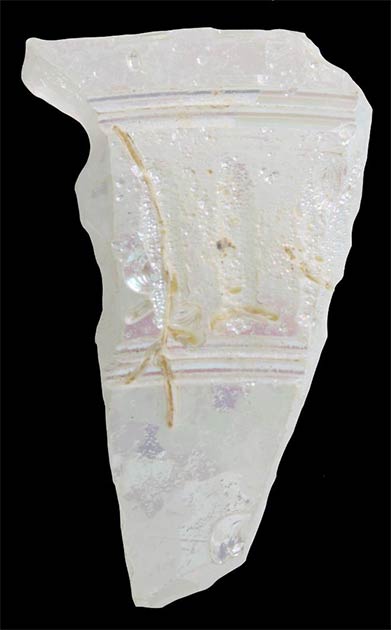
Scientists Prove Rome’s Ancient Glass Was Not From Rome!
Many of the Roman elite enjoyed notoriously luxurious lifestyles. For example, Senators and nobles liked to drink from transparent glasses which were of the highest quality. The origin of the best Roman glass, which was known as ‘Alexandrian,’ has been something of a mystery. Now its place of origin has been established by an international team of researchers. This discovery helps historians to better understand the Roman glass industry and ancient Rome’s economy.
The glass industry in the Roman empire was remarkable for the volume of production and the quality of its product. It made the ‘tesserae,’ or cubes, in mosaics and even windowpanes. According to the research team from Aarhus University release, ‘One of its outstanding achievements was the production of large quantities of a colourless and clear glass, which was particularly favoured for high-quality cut drinking vessels’.
Only the very rich could afford the objects made of this transparent glass. The research team who made the discovery stated that Roman glass was “not surpassed until the rise of the European industries in the eighteenth century,” according to Scientific Reports.
The Mystery of Alexandrian Glass
In 303 AD Emperor Diocletian issued a series of edicts aimed at restoring the economy after the dislocations caused by barbarian invasions and civil wars in the period known as the Third Century Crisis. In one edict he ‘refers to a particularly pricey, colorless glass known as “Alexandrian”’ according to the Smithsonian. Many experts believed that the prestigious glassware originated in Egypt because of its name.
Based on a geochemical analysis of fragments of the rare glass, it is now known how it was produced. Ross Pomeroy is quoted by the Smithsonian as stating that it was made “by adding antimony oxide during the glassmaking process.” This oxidized the sand and allowed the production of glass that was transparent.
However, no one knew just where the Alexandrian glass originated. The “evidence for primary glass furnaces in Egypt is limited,” the team wrote in Scientific Reports. It has been proposed that it originated in the Levant (modern Israel, Lebanon, Palestine, and Syria). There was a cheaper and inferior transparent manganese-processed glass known as Judean or Palestinian glass at the same time. Both regions have sand which is low in lime and this ensures that any glass made is not degradable.

One of the colorless Roman glass sherds from Jerash, Jordan, analysed in this study. Purple splashes are iridescence due to weathering. (Danish-German Jerash Northwest Quarter Project)
Egypt or the Levant
Despite the chemical analysis of the isotopes of Alexandrian and Levantine glass fragments, it was impossible to distinguish them. Therefore, no one could establish where the famous glass originated. Members of the research team wrote in Scientific Reports that “Previous studies have found overlapping strontium and neodymium isotope ratios for Levantine and Egyptian glass.”
Gry Hoffmann Barfod, a geoscientist from Aarhus University, Denmark, was determined to solve the origin of Alexandrian glass. She collaborated with Danish, British, and German specialists on the project. They adopted a breakthrough technology to solve the mystery. Barford told Archaeology that “The new technique measures the isotopes of the rare element hafnium in the glass, which can then be matched to the sands used to make the glass.”
The Roman Glass Mystery is Solved
The interdisciplinary team collected a sample of 37 pieces of glassware from the ancient city of Jerash, which is now in modern Jordan. They were unearthed by the Danish-German Jerash Northwest Quarter Project. The sample included shards of the mysterious Alexandrian glass and the manganese-processed glass. For comparative purposes, the research team also analyzed glass shards from Egypt and the Eastern Mediterranean that were manufactured in modern times.
Based on the ratios of hafnium isotopes found in the ancient pieces of glass they were able to solve the long-standing Roman glass mystery. The specialists were able to prove that the so-called Alexandrian glass did actually come from Egypt.
This was because its levels of hafnium were identical to modern samples from Egypt and different from those from the Levant. The difference in the level of hafnium is probably because the ancient Egyptian glassmakers used iron-poor sands.
- The Beautiful and Complex Artisanship of Glass-making in the Ancient World
- An Unbreakable Story: The Lost Roman Invention of Flexible Glass
- Glass Delusion: Bizarre Medieval Affliction Left People Shattered

Ancient Egyptian glassblowers. (acrogame/Adobe Stock)
Technology Providing New Insights
This find is not only important because it solves a long-standing mystery, but it can also offer experts other insights into the ancient world. Professor Ian Freestone told Eureka Alert that “These exciting results clearly show the potential of hafnium isotopes in elucidating the origins of early materials.” The geochemical testing method can help to establish the isotopes in glass. As a result, it could help economic historians to identify the location of industries, and even major trade routes, in the past.
More work is needed to confirm the findings of the international team, but there is a hope that new geochemical techniques can be used to pinpoint the area of Egypt where the glass was produced. This would help historians to better understand the glassmaking industry and trade in general in Roman Egypt.
Top image: Researchers have solved the mystery of the origins of the best Roman glass. Source: cascoly2 /Adobe Stock
By Ed Whelan















